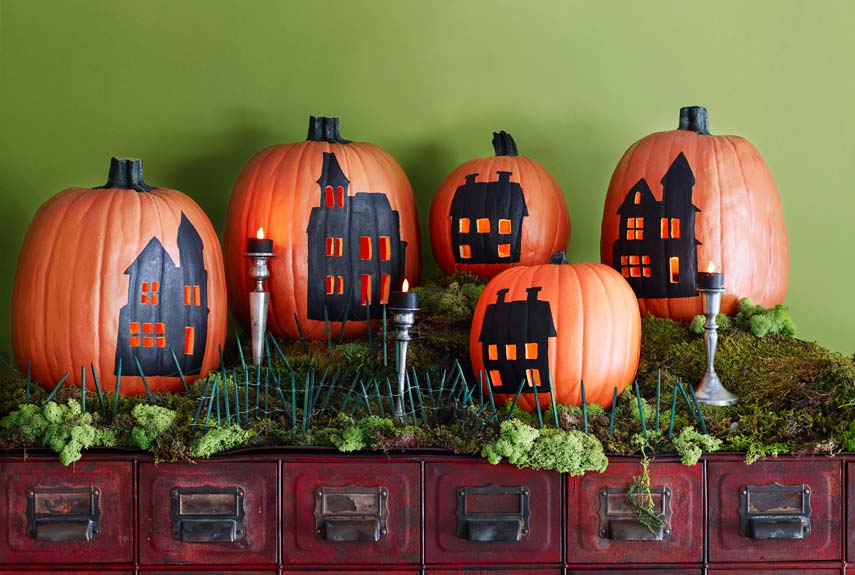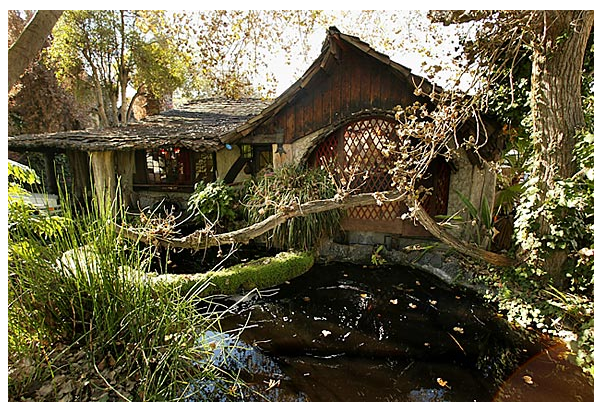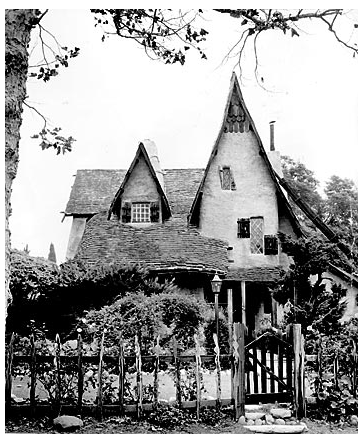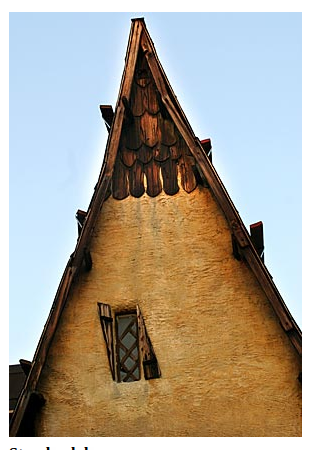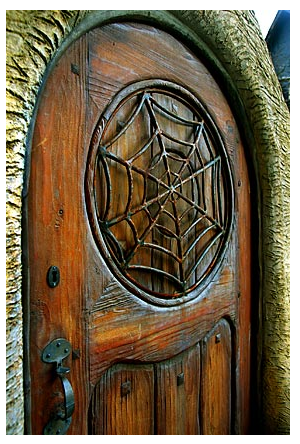Once upon a time (in the early 1900s) hobbit holes and witches dens dotted the Los Angeles landscape. A few are left standing.
I’ve been told that Beverly Hills is filled with domestic fantasies, but most of them hide behind security gates and bland facades. Just about the only house in all the “flats” of this tony city that wears its dreams on its stucco and shingle sleeves is the so-called “Witches’ Cottage” at Walden Drive and Carmelita Avenue.
I presume that this little house is supposed to look frightening because it was designed to resemble the home of the witch who tried to eat Hansel and Gretel, but these days it just comes off as something charming.
The main reason for its current sunny disposition is not only that it is–like almost all properties in the area–relentlessly well-maintained, but also that it is just about the only house around that faces the street. While its neighbors hide behind walls, concrete driveways, garage doors and other utilitarian repellents of urban life, the Spadena House (as it is known today) gives you the full treatment of lawn, picket fence and expressive face that might show up in a child’s rendering of a house.
It is a delight to just walk or drive by this particular lot. True, the picket fence is made out of rough-cut, unpainted wood that seems slapped together, the lawn is bisected by a moat and the gable has been drawn out into a three-story peak that seems to be struggling out of a sea of cedar shakes. But this activity comes off as a visual delight, even if there are undertones of fairy-tale evil.
The way the Spadena House turns its face to you for inspection and then catches your eye with a host of little details makes it an exciting addition to the city. The simple composition of gable and cross gable is placed on a diagonal on the lot so you can see it from all sides. Its exaggerated lines make the form all the more expressive. A curved addition to the rear sweeps away from the street so that the usual long line of utilitarian spaces that you’ll find at the back of such mansions has a certain panache.
The seemingly loose (and functionless) shutters, the covered porch, the expressed timbers, the boulders strewn around the lawn, the chimneys peeking up behind the front and the rough texture of the stucco underscore and define the overall composition.
The Spadena House was created by set designer Henry Oliver in 1921 as the office for a film production company in Culver City. It represents the skills of an experienced form-giver to fantasy more than the scrupulous translation of concerns about function and site into built form that an architect might offer. Later additions (including a skylight that fortunately mars only the alley view of the house) have made it more livable, but ultimately this is not so much a house as a carefully composed image of a house.
You might even think of Oliver (who went on to design some “themed” apartment buildings) as a proto-“imagineer,” which is the name Disney gives to the designers who create the fantasy environments that transform our collective dreams and fears into built form. The Spadena House has all the skill and all the literal-mindedness of Disneyland.
What makes the Witches’ Cottage better than Disneyland, though, is that it is just another house in the middle of Beverly Hills. You don’t have to pay admission to see it, and it isn’t hidden behind gates. It jumps out from the horizontal and forgettable houses all around it. What makes it work is that it does so by using the same gables, stucco, lawn ornaments and their pretensions and then exaggerating them, thus drawing you with it from the world of the everyday into a realized fantasy.
Aaron Betsky teaches and writes about architecture.
Spadena House: Walden Drive and Carmelita Avenue,Beverly Hills
Architect: Henry Oliver, a Hollywood set designer
Soon after Michelle and Jack Conrad bought a little cottage in Beachwood Canyon, a friend came over for a visit. Before leaving, he delicately comforted Michelle: “Don’t worry,” he whispered. “One day you’ll be able to afford a new one.” Thirty years later, Michelle still chuckles at his compassion. The point of the house — even when it was just-built in the early 1930s — has always been to look very old and, well, a little different.
The Conrads’ Hansel-and-Gretel home (now also known among devotees as a “hobbit house”), with its mock thatched roof and heavy rolled eaves, half-timbering and leaded glass windows, is a classic example of Storybook style, a whimsical type of architecture that emerged in Los Angeles with the burgeoning movie industry in the 1920s.
“Storybook houses are an outgrowth of the blurred line of fantasy and reality that is particular to Los Angeles,” says Trudi Sandmeier, a preservationist at the Los Angeles Conservancy. The style pops up across the country, she notes, but it never attained the popularity it enjoyed in L.A. (and to some degree in Northern California). But the trend was short-lived; construction of Storybook-style houses all but stopped by the late 1930s.
Though many fine Storybook structures, which include places that appear to be hobbit houses, witch’s dens, fairy-tale castles and village courts, have been destroyed (just three are designated landmarks in Los Angeles), others still sprinkle the town.
At a time when midcentury Modern is the pinnacle of hip living, when Neutra and Schindler are considered gods by architecture buffs, and when light and space are in high demand, the Storybook style has never seemed more out of fashion. A house with tiny windows, dark and cozy little rooms, and an inherent sense of humor is the opposite of cool. But it’s close to heaven to some.
The Conrads drove by their distinctive cottage for five years, looking at it longingly and always telling each other, “Now, I could live there.” When the house eventually came on the market, a tour of the inside — with its heavy exposed beams, charming nooks and crannies and stone fireplace — convinced them to make an offer. “We were bowled over,” says Jack, a laid-back, rosy-cheeked songwriter and musician who also has a company that creates music applications for computers. They bought the house in 1974 and plan on leaving, Jack says, “feet first.”
Before buying this modest 1,500-square-foot cottage, the Conrads lived in a huge two-story house without a lot of charm. “Big places remind us of hotel lobbies,” Jack says. “It’s just the two of us, and we don’t need anything bigger than this,” says Michelle. Since giving away their large-scale furniture, the couple has filled the tiny rooms of their cozy space with a haphazard assortment of comfortable pieces and antiques collected along the way. The couple didn’t set out to furnish their house “hobbit style” (whatever that might have entailed), but they ended up with a décor that anyone would find inviting.
The house posed another decorating challenge apart from its quaint scale. “There are seven doors, a bank of windows and a fireplace in the living room,” Michelle notes. “The traffic patterns here can be challenging.”
Whoever built the house in 1934 (and its twin just up the street) used quality materials and solid techniques. “We’ve replaced all the electrical and the plumbing since we’ve been here, but after 30 years, that’s just regular maintenance,” Michelle says. The kitchen was dark when they bought it, so the Conrads tore out a bank of cabinets and had a friend replace it with leaded windows to match the existing windows. As he worked, he taught Jack how to do it. “After about 60 years, leaded windows get worn out,” Jack explains. “The lead oxidizes and becomes thin, and the glass gets funky as well.” Room by room, he has since replaced every window in the house.
The roof required more expertise. On a friend’s recommendation, the Conrads hired carpenter Bob Coleman to replace the original bent-and-burned cedar-shake roof with the requisite composite shingles. Working closely with the Conrads, he re-created the wavelike pattern of the original by using three or four times the number of shingles needed for a regular roof. “We kept going down to get more and more shingles,” Jack remembers. “We’re lucky they didn’t run out.”
Since they’ve been there, the couple have maintained the lush garden — a terraced fairy-tale landscape complete with a waterfall, a pond and a misshapen brick pathway that curves up and away to imagined hinterlands. Friends, who have dubbed the place “Conrad Springs,” say coming to the house is like going on vacation. “It’s a comfortable hang,” Jack agrees.
As parking lots started replacing homes on her Culver City street, Martha Joseph scrambled to save her home and her late husband’s legacy from being razed. The eye-catching Storybook complex, one of the best-known examples of Storybook style, was designed and built by Lawrence Joseph starting in 1946. It is remarkable, says the conservancy’s Sandmeier, in that it is “the expression of one man’s creativity come to life.”
Martha Joseph obtained landmark status for the property, then donated an easement on the complex to the Los Angeles Conservancy. She died last year knowing that it would never be torn down.
When people are passionate about the Storybook style, they’ll pay a premium for it, says Beverly Hills Realtor Michael Libow. “Given the paucity of availability, that could be an additional 5% or 10%” on top of market value, he says. But if the person isn’t particularly interested in the style, “they’ll want to pay according to the square footage of the house and of the lot.” It’s these homes that are often razed to make room for more contemporary abodes. Unless, that is, somebody swoops in to save them.
Libow knows this all too well. In 1997, the fabled Spadena House in Beverly Hills, the most famous Storybook house in Los Angeles, came on the market, and Libow started showing it to clients. “All anyone wanted to do was to tear it down,” he laments.
The Witch’s House, as it’s known locally, with its pointy, lopsided roof, tiny windows with shutters that seemed to cling on for dear life, and stucco with a distressed paint job, all surrounded by an overgrown English-style garden and a moat-like pond, wasn’t the home most people dreamed about owning. It didn’t just look old, it looked entirely dilapidated. And since it sat on a prime corner lot in the flats of Beverly Hills, it wasn’t cheap. A tear-down was almost inevitable.
But Libow couldn’t let that happen. “I grew up in Beverly Hills,” he says, “and I always loved the structure.” So, against his better professional judgment, he bought it (at lot value) and is now in the long process of restoring it to its former ramshackle glory. Though nobody wanted to buy — and keep — the house when it was on the market, a lot of people were furious when the black fencing went up around the property. “I got some hate mail from people who thought I was going to tear it down,” Libow says. “The house holds a special place in people’s hearts.”
Like many proud owners, Libow researched the history of his Storybook house. But unlike the others, he was actually able to find a lot of background: It was built in 1921 by Harry Oliver — a studio art director and premier builder of Storybook-style homes — to house the offices and dressing rooms of the Willat movie studio. The house was moved from its original Culver City location to Beverly Hills in 1934. Just two families had lived in it since, first the Spadenas, then the Greens, who gave the interiors a 1960s makeover. It needed revamping inside — and out. By the time Libow bought the house, it didn’t just look as if it was falling apart; it truly was.
He planned on making the place livable by remodeling the kitchen and bathroom, installing heating and repairing some leaks. Then he met Nelson Coates, who, like the original builder, works in the movie industry. Coates, a studio production designer (whose credits include Stephen King’s “The Stand”), talked with Libow about the home’s fantastic possibilities, and the plans changed. Now, almost five years later, the house is nearing the end of a complete peak-to-moat restoration.
“Nothing about the house can be perfect,” Libow says, stressing the difficulty he’s having going against his fastidious ways. “If the house looks too symmetrical, it’s not going to work. We’ve got to create organized chaos.”
Inside, there will be oddly shaped doorways, surfaces that melt into one another, and a bedroom hallway in the shape of a keyhole. Right angles are banned. “We’re going for a Gaudí-esque cottage look,” Libow says, referring to Antonio Gaudí, the iconic Spanish architect whose 1907 Casa Batlló, in Barcelona, is as fantastic as they get. But this will be luxury Gaudí, with Ann Sacks tiles and antique French clay pavers throughout.
Across town in the Los Feliz Hills, a smaller witch’s house, built in 1923, was on the market at about the same time. There wasn’t a feeding frenzy over it either, but Donald Brown and Chris Parson were nervous when they heard who else was interested in the place. “Leonardo was looking at it for his parents,” Brown says under his breath, referring to movie star Leonardo DiCaprio. The couple, both librarians, knew they wouldn’t be able to win that showdown, and were relieved when DiCaprio passed. “It was a miracle for us,” says Brown. “He thought it would be too much work to fix it up.”
Nodding, Parson adds, “I can guarantee that it would have been.”
Not that he’s complaining. He and Brown, who bought the house more than five years ago, have set a long-term goal of restoring it to its glory days when a vibrant socialite named Irene Coursier lived there. “She was the second owner,” Brown says, “and lived here for 65 years until she died.” The men bought the house from her family and are still in touch with the grandchildren. “They were happy to find people who respected the house,” Brown says. So happy, in fact, that a granddaughter sends the men a bouquet of purple roses — Coursier’s favorite — every year on her grandmother’s birthday.
The person who built the house (listed on the title as Rufus Buck) was probably inspired, the men say, by Harry Oliver’s Tam O’Shanter Inn on Los Feliz Boulevard, built the year before in 1922. “The roofline is similar,” Brown points out. The decorative serpentine beams on the exterior of the house are treated in the same way as those on the Tam O’Shanter: They were charred and then sandblasted for an aged look.
During some recent garden work, Parson found a surprise: an engraved silver fork. “It must have fallen off the balcony during one of Mrs. Coursier’s dinner parties,” he mused as he packed it up to send to her granddaughter in San Diego. With each weekend they spend in the dirt, the couple unearth a little more history and get closer to their vision: a garden, with a bubbling waterfall, that would make Coursier proud.
As the remodeling work began on the house (“We’re doing it all ourselves,” Brown says. “It would cost a fortune otherwise”), the men asked Coursier’s descendants to send pictures of the house in its heyday. The men studied the original colors, fixtures and furnishings and referred to them as they decorated.
For added privacy on the street side of the house, they decided to replace the clear windows with stained glass. Working with design elements from the house — pointed gables, the fireplace and the original colors — Brown designed a pattern that looks as if it was there from the start.
When Dodonna Bicknell, a British commercial executive producer, walked for the first time into her miniature 1924 Pierpont Davis-designed Normandy-style castle, she knew that if she bought it, she would need new furniture. The distinctive interiors, including an arched 18-foot living room ceiling, arched doors, stained glass windows and a surprisingly Moorish vibe, got her thinking. She didn’t have a specific era in mind, but rather let her keen eye choose pieces according to their shapes and sizes. “I wanted it to look like an English men’s club,” she says, “but with femininity.”
To get the look, she hung a glittering crystal chandelier above a heavy wood dining set she wrangled from a friend. She re-covered the seats in royal blue, and it looks perfect in the rounded dining room, at the base of the home’s turret. Bicknell’s use of rich jewel tones elsewhere in the house plays off the stained glass windows and helps keep the somewhat rigid décor from looking austere.
Bicknell hadn’t been looking for a castle, but she was looking for charm. When she saw a picture of the house, with its vine-covered turret and bold coat of arms over the front door, in a newspaper’s real estate section, she was intrigued. “It wasn’t in the neighborhood I wanted, and they were asking a lot of money for it,” she says, but she couldn’t resist. “People who like this house love it.”
Like the others with their distinctive homes, Bicknell often finds strangers outside, snapping shots of her place. Unless, that is, Mister Smith, Bicknell’s enormous, terrifying and incredibly solid 120-pound Doberman pinscher — the most appropriate addition to the house — is outside protecting his castle.
*
Storybook style resources
John Robert Marlow, a science fiction writer with a passion for Storybook style, was so disappointed about the lack of information on the subject that he did something about it. “I started my website out of frustration that there wasn’t anything about them out there,” he says. His site is among several sources — including books and vendors — that offer information on the Storybook look and how to find the materials used to create it. Among the choices:
General information
Book: For a complete history of the style and for extensive photographs of Storybook-style houses, see “Storybook Style: America’s Whimsical Homes of the Twenties” by Arrol Gellner and Douglas Keister (2001, Viking Studio).
Website: In addition to his website, Marlow plans on starting an online group of Storybook enthusiasts. In the meantime, his website is
http://johnrobertmarlow.com/sa__storybook.html
.
 Tired of the same old holiday posts? Try writing about these!
Tired of the same old holiday posts? Try writing about these!
